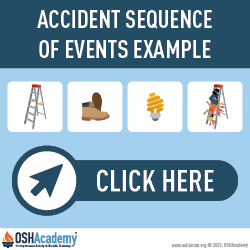Accident Scenario
Step 4. Construct the Sequence of Events
Now you've gathered tons of information about the accident, and it's piled high on your desk. What do you do with it?
You must go through the facts collected during your investigation. This will help you create an accurate sequence of events that contribute to and include the actual injury event.
Actor and Action
Each event describes an actor (a person or thing that does something) and an action (what the person or thing does).
An event might state, "Employee #1 stands on the top rung of the ladder." In this example, "Employee #1" is the actor, and "stands on the top rung of the ladder" is the action.
Understanding the sequence of events leading up to an accident is very important. The following sequence of events is based on a real-life accident that resulted in the death of an employee.
- Employee #1 returned to work from lunch at 12:30 p.m.
- At approximately 12:45 p.m., employee #1 picked up a 15-foot irrigation pipe.
- Employee #1 oriented the irrigation pipe vertically.
- The pipe contacted a sagging high voltage power line running directly over the work area.
- When the pipe contacted the powerline, a lethal surge of electrical current electrocuted Employee #1.
- Employee #2 heard a "zap" and saw a "flash."
- Employee #2 turned to see employee #1 falling to the ground.
- Employee #2 attempted to awaken Employee #1.
- Employee #1 did not respond to Employee #2's attempt.
- At 12:50 p.m., employee #2 called 911 and requested immediate EMT help.
- At about 12:55 p.m., paramedics arrived.
- The paramedics immediately began treatment in an attempt to stabilize employee #1.
- At about 1:10 p.m., an ambulance arrived to transport Employee #1 to the hospital.
- Hospital emergency room doctors pronounced Employee #1 dead at 1:30 p.m. Cause of death was electrocution.
You can read more about constructing the sequence of events in OSHAcademy Courses 162, Accident Investigation Basic, and 702, Effective Accident Investigation.
Knowledge Check Choose the best answer for the question.
6-7. What should each event in the accident sequence of events include?
You forgot to answer the question!

